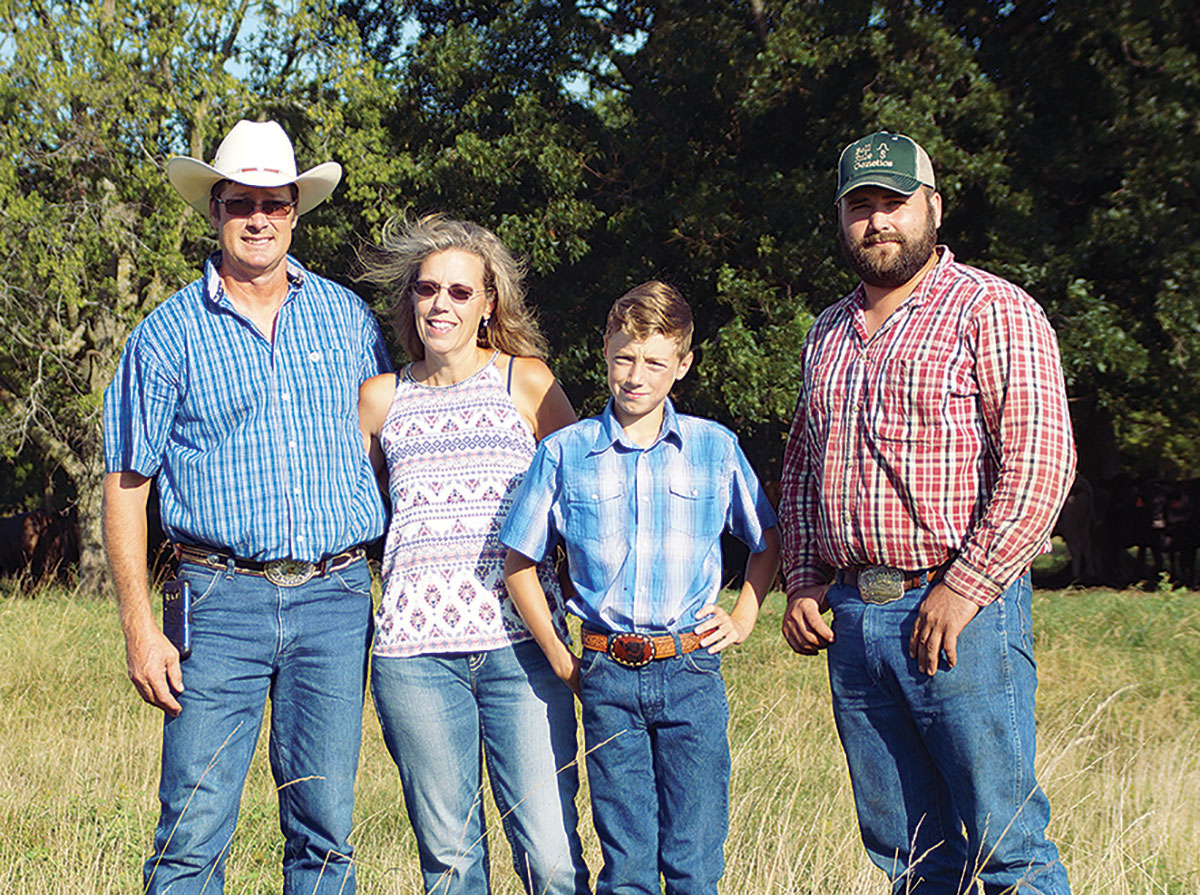
Bell Rule Genetics finds great success with rotational grazing and Senepol genetics
Bell Rule Genetics in Mayes County, Okla., is a 100-year-old family cattle operation.
The ranch strives to produce the highest percentage of quality meat for the least cost. One method Dean Schneider and his nephew Brandon Fix use to achieve that goal is intensive rotational grazing.
One of their rotational plots, 20 acres, fed 60 pairs for 45 days on millet and haybeans. A rain this year made the forage too mature to bale. Dean said he put down the wings of the mower and mowed strips that Brandon fenced off with hot wire. The pairs were left for one or two days on each strip. Turns out the cattle “ate it up.”
“There was no baling cost and it saved our grass,” Dean said.
Brandon said with planned and limited grazing, the ranch has only recently begun to feed hay for the first time this winter.
“Generally it’s a day’s grazing and move them daily, but even if you have a job in town and can only move the cows on the weekend, it will still work well,” Dean said.
He said recent studies show 80 percent of grass is used when grazing is limited to a specific area, compared to 30 percent when cattle are left to room large pastures.
“When you limit the area to the green for protein, it’s like a supplement,” Dean said.
While some labor is involved to put up the electric tape, Brandon said he can put up a quarter mile in about 10 minutes. He said once a person perfects the right way to put up the electric fence, it is quickly accomplished.
“Weeds are interesting,” Dean said. “We come from farm country and it’s born and bred in us to spray weeds. By moving cows (in rotation) they eat the weeds, too, and lots of weeds will bring up needed minerals because they have a tap root system. And because different plants use different things from the soil, a diversity of plants will out produce a monoculture.”
Brandon said the cows will eat weeds better when confined with daily moves and they will strip the leaves off some of the worst varieties such as cockleburr.
“They won’t eat what makes them sick,” Brandon said. “This whole deal is based before man became involved.”
It must be working. Bell Rule averages selling calves at 550 pounds that have had no creep.
Rotational grazing is what prompted the ranch to get into Senepol cattle. When the pastures were fenced off in strips, that left some times where there was no shade available. The black Angus cattle were getting heat stressed in some of these situations, so the hunt began for a heat-resistant breed to cross on the Angus and increase their heat resistance.
“We researched all the African breeds,” Dean said.
As it turns out, most African-origin breeds are Bos taurus genus and species as common English breeds are, and not Bos indicus like Brahmans. The biggest difference between Bos taurus and Bos indicus are sweat glands, but adaptability to heat and insect resistance is more than just sweating.
Senepol cattle were developed on the island of St. Croix in the 1950s. N’Dama cattle were mixed with Red Poll. The N’Damas are European tarina zebu cattle which have high heat tolerance and insect resistance. They are docile and good meat and milk producers. Dean said Senepols have more hair follicles than the Angus, even though the hair has mutated to be slick.
“Their temperature will be about two degrees lower in the sun,” Dean said.
The Senepols are red and resemble Santa Gertrudis in appearance. Brandon has photos of Angus and Senepol in the same pasture when it was very hot last summer. The Angus cattle are laid up under the trees in the shade and the Senepols are in the sun grazing.
Bell Rule’s end goal is to raise commercial cows that are quarter-blood Senepol. They have an F1 generation of half Senepol half Angus on the ground now.
“We’re in the business of raising commercials bulls,” Schneider said, although they have registered Angus bulls for sale also. The price range is generally $2,500 to $3,500. The ranch has a field day where buyers can look at and purchase the bulls. All will be semen tested. That doesn’t mean the ranch will not sell private treaty any time. The field day bulls will be offered at 18 months old.
Bell Rule is 1,700 acres and runs 300 commercial and 150 registered cows. Some of the calves are fed out on the ranch anywhere from 45 days to ready to butcher, depending on the market and feed costs. Yearlings that are fed to slaughter weight are sold to National Beef in Dodge City, Kan.
Now that they are breeding toward the quarter Senepol cross, Brandon said the ranch may keep all the heifers from this calf crop, because “eye appeal is not necessarily the best culler,” Brandon said.
To increase forage rates, Dean has drilled sorghum, mungbeans, millet and other crops into stubble on the pasture. Right now he is trying triticale.
Things change in the cattle business. At Bell Rule Genetics, the family strives to keep up with those changes by education, experimentation and hard work.






